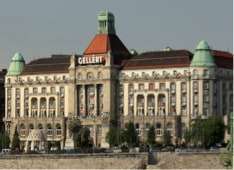May 15th, 2014
Several years ago I had the pleasure of traveling to Budapest to attend the EAIE Conference. The Soviet Union had recently collapsed and its satellite states and neighboring countries, such as Hungary, had abandoned their socialist regimes and embracing democracy and western European trends. Hungary was one of the first communist-era countries to oppose the Soviet regime during the Cold War, notably with the Hungarian Revolution of 1956. In 1989, Hungary was the first communist-block country to open its borders with Western Europe.
Budapest, from what I’ve been told by relatives living in Vienna, was always a fun destination to visit for a weekend even during its communist period. Many Austrians would travel to Budapest for day trips to visit its farmer’s markets, shop, and dine at its restaurants and cafes where prices were low and quality exceptional. I was staying, along with several other EAIE conference attendees, at the famous Hotel Gellért across the Danube, known for its spa and hot springs.
Here are a few interesting facts about this old country with a very rich history:
1. Hungary is a land-locked country in Central Europe sharing its borders with Austria, Croatia, Romania, Serbia, Slovakia, Slovenia and Ukraine. The population of Hungary is 9,919,128.
2. Its capital city is Budapest with a population of 1.709 million (2011).

3. Hungary was once part of the Celtic world, then the Roman Empire. Following the fall of Rome, the Huns settled in the plains of Pannonia and gave their name to Hungary.
4. Founded in 897, Hungary is one of the oldest countries in Europe (before France and Germany became separate entities, and before the unification of Anglo-Saxon Kingdoms.)
5. Around 1000 CE, the Kingdom of Hungary was one of the largest states in Europe, bigger than France. Later, it became one of the two “eagle heads” of the Austro-Hungarian Empire.
6. Hungarian language is known as Magyar and is the direct descendent of the language spoken by the Huns. It is not an Indo-European language and has only two related languages in Europe (Finnish and Estonian).
7. Around two-thirds of the Hungarian people are Roman Catholic, about a quarter are Calvinist. The rest of the population is either belongs to the Lutheran, Jewish, Greek Orthodox.
8. The country fell under communist rule following World War II.
9. The 1986 Hungarian Grand Prix was the first Formula One race to take place behind the Iron Curtain.
10. Communism in Hungary ended 1989 and the country became a parliamentary republic. It joined NATO in 1999 and the EU five years later.
11. Inventions by Hungarians in Hungary include the noiseless match (by János Irinyi), Rubik’s cube (by Erno Rubik), and the krypton electric bulb (Imre Bródy).

Erno Rubik
12. Remember, earlier I’d mentioned the spa and the hot springs at the Hotel Gellért? Hungary has one of the most important thermal spring cultures in Europe. The country boasts no less than 1,500 spas, typically featuring Roman, Greek and Turkish architecture.

Gellért Hotel

Spa at the Hotel Gellért
13. Hungary has a long tradition of classical music with famous composers like Béla Bartók, Zoltán Kodály and Franz Liszt.
14. As of 2007, 13 Hungarians had received a Nobel Prize (this is more than Japan, China, India, Australia or Spain) in every category except peace.
15. Spends 4.9% of GDP (2010) on Education.
16. Literacy of total population is 99%.
17. Hungarians won gold medals at every summer Olympics except Antwerp 1920 and Los Angeles 1984 when they did not compete.
18. According to 2013 OECD figures: “As in other Eastern European countries, upper secondary attainment in Hungary is traditionally high (82% for 25-64-year-olds, compared with an OECD average of 75%). This applies across all age groups: 87% of 25-34 year-olds and 75% of 55-64 year-olds hold an upper secondary qualification against an OECD average of 82% and 64%, respectively.
19. Hungary has, together with Sweden and the US, the lowest completion rate at tertiary level among OECD countries: in 2011, only 53% of students graduated from the program they entered, in comparison with the OECD average of 68%.
20. Basic education lasts for eight years divided into two stages of four years each. Secondary education is provided in academic secondary schools (gimnázium) or vocational secondary schools (szakközépiskola).
21. Hungarian higher education has a dual system with colleges and universities. Some colleges are associated with universities and operate as college faculties within universities. A university can also offer college level courses. The duration of training at college level is minimum 3 years, maximum 4 years; the duration of education at university level is minimum 4 years, maximum 5 years (with the exception of medical universities where it is 6 years). According to the binary pattern, colleges and universities grant Főiskolai Oklevél (College-level Degree) and universities grant Egyetemi Oklevél (University-level Degree). Universities organize three-year PhD courses, specialized further education courses (with a normal duration of one to three years) and various continuous education courses.
22. The University of Pécs, the oldest university of Hungary, was founded in 1367.

University of Pécs
23. Hungary is also reputed to host cultural events like Sziget Festival or Budapest Spring Festival. The Sziget Festival is the Hungarian for “Island” and is one of the largest music and cultural festivals in Europe. It is held every August in northern Budapest, Hungary, on Óbudai-sziget (“Old Buda Island”), a leafy 108-hectare (266-acre) island on the Danube. The Budapest Spring Festival is one of the country’s oldest festivals and takes place each year in March and attract artists and musicians from around the world.

Sziget Festival, Budapest

Budapest Spring Festival
24. Did you know there are cowboys in Hungary? I was happily surprised to be taken to a ranch where cowboys, or csikos as they are called in the region showed off their prowess on horseback. Horsemanship in Hungary has a long history, going back to the Magyars, the first Hungarians. They rode from central Asia to settle in present day Hungary. The tradition is best seen on the Great Plain (Puszta), a vast flat plain reminiscent of the American Old West.

25. And no post on Hungary is complete, without mention of its famously delicious and flavorful Gulyásleves (gulyás is herdsman, leves is soup in Hungarian); a Hungarian soup, made of beef, vegetables, ground paprika and other spices. It originates from a dish cooked by the cattlemen (gulyás also means herdsman) who tended their herds in the Great Hungarian Plain, known as the Alföld or Puszta in Hungarian. Egészségedre (enjoy)!

Sources:
http://www.ymtvacations.com/travel-blog/hungarian-cowboys-a-rich-cultural-traditions
http://eugo.gov.hu/key-facts-about-hungary/history
http://www.oecd.org/edu/Hungary_EAG2013%20Country%20Note.pdf
http://www.nefmi.gov.hu/letolt/english/education_in_hungary_080805.pdf
http://www.euroeducation.net/prof/hungarco.htm

Jasmin S. Kuehnert
President & CEO ACEI
www.acei1.com


